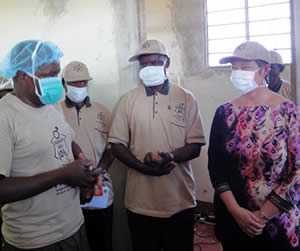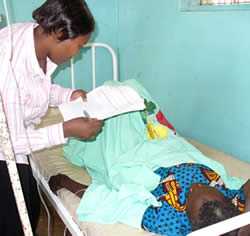
CDC has worked with the United Republic of Tanzania and more than 60 partner organizations since 2001 to address HIV, malaria, and other health threats by helping support service delivery and strengthen health systems and infrastructure. CDC addresses HIV, malaria, and other health threats by providing technical and financial assistance to support service delivery, strengthen health systems and infrastructure, and develop and use strategic information.
Download Overview Fact Sheet
 Staff
Staff
CDC office (physical presence)
57 Locally Employed
14 Direct Hires
14 Contractors/Fellows
 Tanzania at a Glance
Tanzania at a Glance
Population: 51.82 million
Per capita income: $920
Life expectancy: 64.3 yrs
Under 5 mortality: 48/1000 live births
Source: The World Bank
 Top 10 Causes of Death
Top 10 Causes of Death
Source: GBD Compare, 2013
- HIV 17%
- Lower Respiratory Infections 11%
- Malaria 7%
- Diarrheal Diseases 6%
- Tuberculosis 5%
- Cancer 5%
- Ischemic Heart Disease 3%
- Stroke 3%
- STDs 3%
- Sepsis 2%
What CDC Is Doing
In the News
- Page last reviewed: August 8, 2016
- Page last updated: August 8, 2016
- Content source:
Global Health
Notice: Linking to a non-federal site does not constitute an endorsement by HHS, CDC or any of its employees of the sponsors or the information and products presented on the site.



 ShareCompartir
ShareCompartir

 Through the Global Health Security Agenda (GHSA) and FELTP, CDC’s Division of Global Health Protection helped the Ministry of Health establish Tanzania’s first public health emergency operations center (EOC), which is responding to the 2015-16 cholera epidemic. CDC also supports the implementation and strengthening of the Integrated Disease Surveillance and Response System, which serves as the detection and reporting system for reportable diseases in Tanzania.
Through the Global Health Security Agenda (GHSA) and FELTP, CDC’s Division of Global Health Protection helped the Ministry of Health establish Tanzania’s first public health emergency operations center (EOC), which is responding to the 2015-16 cholera epidemic. CDC also supports the implementation and strengthening of the Integrated Disease Surveillance and Response System, which serves as the detection and reporting system for reportable diseases in Tanzania.